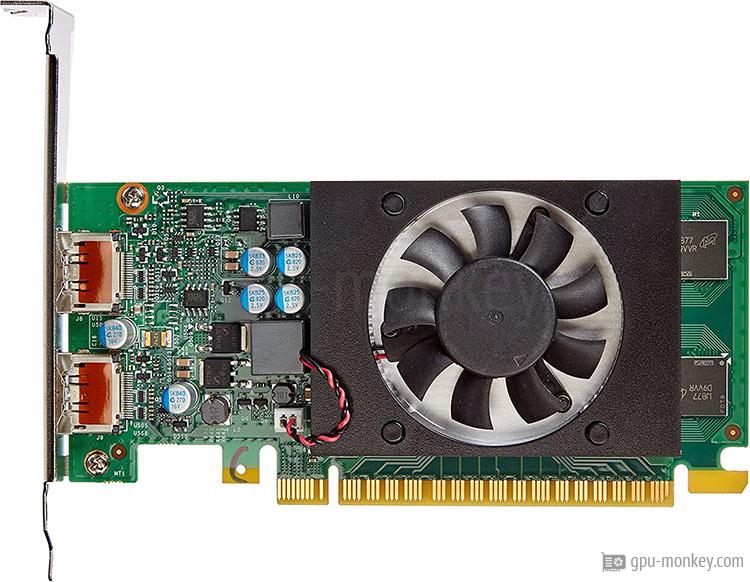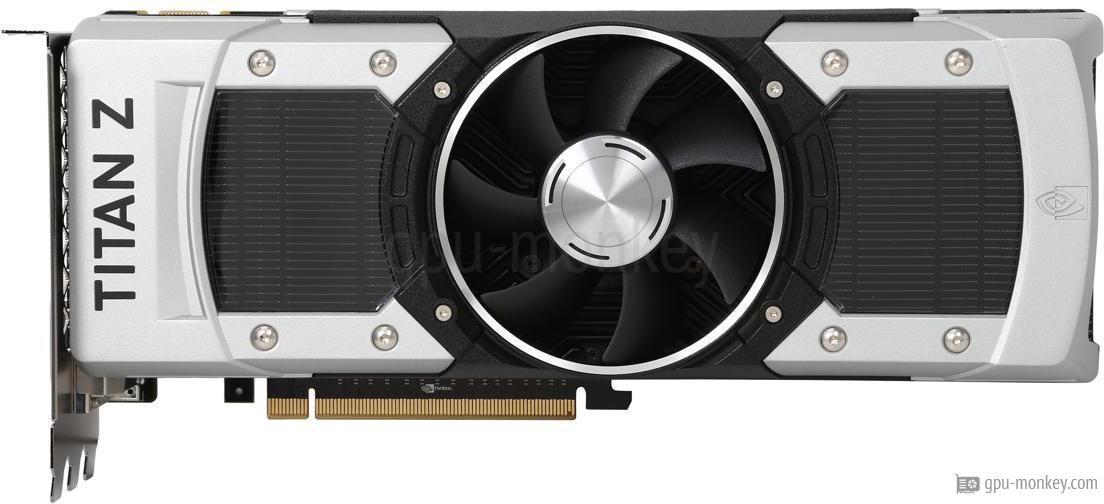NVIDIA GeForce GT 730
vs
NVIDIA GeForce GTX TITAN Z
GPU comparison with benchmarksThe NVIDIA GeForce GT 730 is based on the NVIDIA GeForce GT 730 (Kepler 2.0) and has 1 GB GDDR5 graphics memory with a bandwidth of 40 GB/s.
The NVIDIA GeForce GTX TITAN Z is based on the NVIDIA GeForce GTX TITAN Z (Kepler) and has 12 GB GDDR5 graphics memory with a bandwidth of 672 GB/s. |
||
GPUThe NVIDIA GeForce GT 730 has the GK208-302-B1 graphics chip installed, which is based on the Kepler 2.0 architecture. The NVIDIA GeForce GTX TITAN Z is based on the graphics chip 2x GK110-350-B1, which comes from the Kepler architecture. |
||
| NVIDIA GeForce GT 730 | GPU | NVIDIA GeForce GTX TITAN Z |
| NVIDIA GeForce GT 730 | Based on | NVIDIA GeForce GTX TITAN Z |
| GK208-302-B1 | GPU Chip | 2x GK110-350-B1 |
| Kepler 2.0 | Architecture | Kepler |
| 2 | Streaming Multiprocessors | 30 |
| 384 | Shader | 5760 |
| 8 | Render Output Units | 96 |
| 32 | Texture Units | 480 |
| 0 | Raytracing Cores | 0 |
MemoryThe graphics memory of the NVIDIA GeForce GT 730 clocks at 1.253 GHz, which corresponds to a speed of 5.0 Gbps. The graphics memory speed of the NVIDIA GeForce GTX TITAN Z is 7.0 Gbps and the clock speed is 1.750 GHz. |
||
| 1 GB | Memory Size | 12 GB |
| GDDR5 | Memory Type | GDDR5 |
| 1.253 GHz | Memory Clock | 1.750 GHz |
| 5.0 Gbps | Memory Speed | 7.0 Gbps |
| 40 GB/s | Memory bandwidth | 672 GB/s |
| 64 bit | Memory Interface | 768 bit |
Clock SpeedsThe clock frequency of a graphics card determines the speed in connection with the graphics architecture. |
||
| 0.902 GHz | Base Clock | 0.705 GHz |
| 0.902 GHz | Boost Clock | 0.876 GHz |
| Avg (Game) Clock | ||
| No | Overclocking | Yes |
Thermal DesignThe NVIDIA GeForce GT 730 is powered by connectors. The TDP (Thermal Design Power) of the graphics card is 38 W. The NVIDIA GeForce GTX TITAN Z has 2 x 8-Pin PCIe power connectors that supply it with energy. The manufacturer specifies the TDP of the card as 375 W. |
||
| 38 W | TDP | 375 W |
| -- | TDP (up) | -- |
| Unknown | Tjunction max | 95 °C |
| PCIe-Power | 2 x 8-Pin | |
Cooler & FansThe NVIDIA GeForce GT 730 is equipped with a total of 0 -- main fans. The NVIDIA GeForce GTX TITAN Z has 1 Axial main fans that cool the GPU and memory. |
||
| -- | Fan-Type | Axial |
| -- | Fan 1 | 1 x 80 mm |
| -- | Fan 2 | -- |
| Air cooling | Cooler-Type | Air cooling |
| dB | Noise (Idle) | 0 dB |
| -- | Noise (Load) | -- |
ConnectivityUp to 3 screens can be operated with the NVIDIA GeForce GT 730. The NVIDIA GeForce GTX TITAN Z supports the operation of a maximum of 4 monitors. |
||
| 3 | Max. Displays | 4 |
| 2.2 | HDCP-Version | 2.2 |
| 1x HDMI v1.4a | HDMI Ports | 1x HDMI v1.4a |
| -- | DP Ports | 1x DP v1.2 |
| 1 | DVI Ports | 2 |
| 1 | VGA Ports | -- |
| -- | USB-C Ports | -- |
FeaturesetWith the NVIDIA GeForce GT 730 it is possible to operate a screen with a maximum resolution of up to 3840x2160 pixels. The maximum supported resolution of the NVIDIA GeForce GTX TITAN Z is 4096x2160 pixels. |
||
| 3840x2160 | Max. resolution | 4096x2160 |
| 12 (11_1) | DirectX | 12 (11_1) |
| No | Raytracing | No |
| No | DLSS / FSR | No |
| No LED lighting | LED | No LED lighting |
Supported Video CodecsThe support and acceleration of certain video codecs can have a positive impact on the lower energy consumption and less waste heat from the graphics card. |
||
| Decode | h264 | Decode / Encode |
| No | h265 / HEVC | No |
| No | AV1 | No |
| No | VP8 | No |
| No | VP9 | No |
DimensionsThe NVIDIA GeForce GT 730 is connected to the system via PCIe 2.0 x 8 lanes and requires 1 PCIe-Slots space in the housing. The NVIDIA GeForce GTX TITAN Z needs the space of 3 PCIe-Slots in the case and has a PCIe 3.0 x 16 Lanes interface. |
||
| -- | Length | 267 mm |
| -- | Height | 111 mm |
| -- | Width | 62 mm |
| 1 PCIe-Slots | Width (Slots) | 3 PCIe-Slots |
| -- | Weight | -- |
| PCIe 2.0 x 8 | GPU Interface | PCIe 3.0 x 16 |
Additional dataThe NVIDIA GeForce GT 730 has been manufactured with a structure width of 28 nanometers since Q2/2014. The NVIDIA GeForce GTX TITAN Z came on the market in Q2/2014 and will have a structure width of 28 nanometers manufactured. |
||
| -- | Part-no | -- |
| Q2/2014 | Release date | Q2/2014 |
| 59 $ (Reference) | Launch Price | 2,999 $ (Reference) |
| 28 nm | Structure size | 28 nm |
| -- | Documents | -- |
Rate these graphics cards now
Benchmark results
Geekbench 6 (OpenCL, Vulkan, Metal)
Geekbench 6 is a cross-platform benchmark for main processors, which also carries out 3 different graphics benchmarks and outputs them in the form of a numerical value.
Geekbench 6 - OpenCL
|
|
NVIDIA GeForce GTX TITAN Z
12 GB GDDR5 |
||
FP32 Performance (Single-precision TFLOPS)
The theoretical computing power of the graphics card with single precision (32 bit) in TFLOPS indicates how many trillion FP32 floating point operations the graphics card (GPU) can perform per second.
FP32 (TFLOPS)
|
|
NVIDIA GeForce GT 730
1 GB GDDR5 |
||
|
|
NVIDIA GeForce GTX TITAN Z
12 GB GDDR5 |
||





